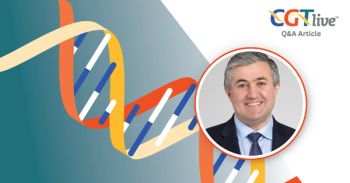
Allogeneic Hematopoietic Stem Cell Transplantation Replicates Posititve Outcomes in Transfusion-Dependent Thalassemia
Allo-HSCT showed good 2-year survival data, with matched sibling donors showing superior outcomes to alternative donors.
New 3-year event-free survival data from a phase 4 prospective trial (NCT04009525) in China assessing the validity of a prior study of patients with transfusion-dependent thalassemia (TDT) who underwent allogeneic hematopoietic stem cell transplantation (allo-HSCT) suggest that the approach can be effective, particularly when done with matched sibling donors (MSDs). The data were presented at
The study, which included 823 total patients from 18 centers in China for a 4-year period, featured 331 individuals who received transplants with MSDs, 352 individuals with matched unrelated donors (MUDs), and 140 with haploidentical related donors (HIDs). All told, the full cohort’s 2-year overall survival (OS) rate was 95%, as was the event-free survival (EFS) rate for the same period. The MSD cohort reported an OS and EFS of 97%, the latter of which was deemed slightly superior to the alternative donor groups at 97% (95% CI,95-99) compared with 93% (95% CI, 91-96), respectively (HR, 2.39; 95% CI, 1.14-5.01; P = .022).
Similarly, the 2-year transplant-related mortality (TRM) rate was higher among alternative donor recipients than MSD recipients, at 5.8% (95% CI, 3.7-7.9) compared with 2.5% (95% CI, 0.8-4.2) for a hazard ratio of 2.34 (95% CI, 1.06-5.14; P = .035).
We had reported an encouraging outcome of allo-HSCT in a single center study, which the 3-year [EFS] was 97% in patients with TDT transplanted with HLA-matched sibling donors. We aimed to confirm this result and to assess the outcomes of allo-HSCT for TDT patients transplanted with alternative donor,” Rongrong Liu, MD, of the department of hematology at the First Affiliated Hospital of Guangxi Medical University, in Nanning, China, and coauthors wrote. “We report excellent 2-year OS and EFS… Allo-HSCT with alternative donors can be considered as a frontline option for TDT patients lacking matched sibling donors. Patients receiving alternative donors will also benefit from an improved GvHD-prophylaxis strategy.”
READ MORE:
Graft failure (GF) and graft-versus-host disease (GVHD) have presented significant challenges to the success of allo-HSCT procedures in patients with TDT. The study’s secondary outcomes evaluated complications such as infection rates, graft failure, and GVHD incidence.
The incidence of GVHD was significantly lower in MSD recipients compared with alternative donor groups, with grades 2-to-4 and 3-to-4 acute GVHD rates 7.5% and 1.9%, respectively, for MSD recipients, and rates of 28% and 15% in MUD recipients and 32% and 15% in HID recipients (P <.0001 for both). Similarly, moderate-to-severe chronic GVHD rates were 5% for MSD recipients, lower than 11% for MUD recipients (P <.001) and 15% for HID recipients (P <.05).
Those who received HID experienced higher rates of infectious complications, including pneumonia (49%), cytomegalovirus (52%), and Epstein-Barr virus (33%) reactivation, compared with the other 2 groups of recipients. Rates of bacterial and fungal infections, septicemia, hepatic veno-occlusive disease, and posterior reversible encephalopathy syndrome were comparable across the 3 groups.
Multivariate analysis identified a group of factors that were associated with poorer OS and EFS, namely that recipients were older than 15 years (HR, 3.07 and 2.88, respectively), if grade 2 to 4 acute GVHD occurred (HR, 5.24 and 4.56, respectively), and if there was prior splenectomy (HR, 3.36 and 3.15, respectively).
The median patient age was 8 years (IQR, 5-11), and the median follow-up was 23 months (IQR, 13-36). The study followed the GX-07-TM protocol, with a conditioning regimen consisting of busulfan (Bu; 16mg/kg), cyclophosphamide (Cy; 200 mg/kg), fludarabine (Flu; 150 mg/m2), and anti-thymocyte (ATG, 10mg/kg). The GVHD prophylaxis was cyclosporine A (CsA), methotrexate (MTX), mycophenolate mofetil (MMF) for patients with matched sibling donors and tacrolimus (Tac), MTX, MMF for patients with matched unrelated donors or haploidentical related donors.
For more coverage of ASH 2024,
Reference
Liu R, Xiao H, Qin C, et al. A Multi-Center Clinical Trial of Allogeneic Hematopoietic Stem Cell Transplants in Transfusion Dependent Thalassemia. Presented at: ASH 2024 Annual Meeting & Exposition. December 7-10; San Diego, CA. Abstract #378.
Newsletter
Stay at the forefront of cutting-edge science with CGT—your direct line to expert insights, breakthrough data, and real-time coverage of the latest advancements in cell and gene therapy.
















































